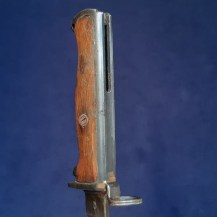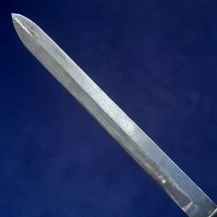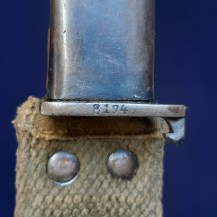Norwegian M1894 Bayonet Converted for the M1 Carbine
Unfullered spear-pointed blade, wood slab grips secured by a single screw, steel one-piece hilt, backstrap and pommel with integral sprung locking mechanism in the hilt, that both locks the bayonet to its scabbard and locks it onto a rifle. Muzzle ring attached by brazing, 1.45cm in diameter. Steel scabbard with projecting hook on the throat piece to engage with the locking mechanism, integral green canvas frog with wire loop webbing hooks and buttoned retaining strap, also attached by brazing to the scabbard body. Blade 20.6cm in length, 32.6cm overall.
The blade is stamped at the ricasso with a crown and ‘K’, the maker’s mark of Kongsberg Våpenfabrikk (Kongsberg Weapons Factory). The hilt is stamped with ‘7’. The throat piece of the scabbard is stamped with the serial number ‘8174’.
Norway received rifles from the United States under its Military Assistance Program from 1950 until 1963, with nearly 100,000 M1 and M2 Carbines delivered. The M1 was designated the Selvladekarabin M1 (Self-loading Carbine M1) in Norwegian service. Some US-made M4 bayonets for these rifles were delivered but were clearly insufficient in number, as Norway manufactured its own copy of the M4 bayonet at the Kongsberg arsenal, then opted to convert some of its existing stocks of M1894 bayonets made for the Krag Jorgensen rifle to fit the M1. Norway had an oversupply of this bayonet due to a new production run ordered in 1943 during their occupation by Nazi Germany.
30,000 bayonets were modified in 1956-57, probably at Kongsberg, by brazing on a new muzzle ring and modifying the locking mechanism in the mortise. A further 1,000 were converted by the Hærens Våpentekniske Korps. This is not one of the wartime production run (which have Waffenamt stamps, and lack a ball finial on the scabbard), but an original M1894, made between 1912 and 1926.
All metal parts have a blued finish, with a small amount of wear on raised edges, eg the beak of the pommel. Some small dents to the chape end of the scabbard, which do not interfere with sheathing. One of the grip scales (on the inside as worn) has a small crack next to the locking button and denting to its surface.












